The Northern Arena: The Need to Revitalize Israeli Policy
Udi Dekel, Carmit Valensi, and Orna Mizrahi
Trends
Iran’s entrenchment efforts continue · Development of capabilities to attack Israel from Lebanon, Syria, and western Iraq · Strengthened air defense systems in Syria and Lebanon · Assad regime is in partial control of Syria · Economic crisis in Lebanon
The Northern Arena: The Need to Revitalize Israeli Policy
Udi Dekel, Carmit Valensi, and Orna Mizrahi
Recommendations
Continue the campaign between wars · Coordinate with Russia · Cultivate ties with elements that oppose Assad and Iran · Launch an international plan to rebuild Lebanon, reduce Hezbollah influence, and block the precision missile project · Prepare for a multi-arena war
The changes on the northern front, particularly the ongoing Iranian efforts to consolidate its presence there (even though this has been obstructed to some extent), the precision missiles and rockets project in Lebanon, and the worsening economic crisis in Lebanon and Syria highlight Israel’s need to adjust its policy to address the unfolding challenges more effectively. Israel’s campaign between wars continues to lead the efforts to stop Iran, but clearly this policy does not provide a full response to the challenges, particularly the growing threat of the precision missiles project in Lebanon. Consequently, this policy is both increasingly tenuous and volatile, and may well lead to escalation and expansion of the conflict to additional fronts. As part of an updated response, Israel must integrate both hard and soft power efforts, including a more active role by the United States and regional players in the effort to achieve an arrangement for the Syrian theater. The Biden administration should be encouraged to coordinate both efforts with Russia regarding the Iranian threat from Syria, and efforts with France and Saudi Arabia to formulate a recovery plan for Lebanon to help stabilize the country, while reducing Hezbollah’s influence there. Beyond this, it is essential for Israel to devise operational capability against the precision project in Lebanon, and from a broader perspective, to formulate a revised strategic objective for scenarios of a future large-scale war against the Iranian-Shiite axis on the northern front – Lebanon, Syria, and western Iraq.
Syria
Following years of a military and diplomatic stalemate in the Syrian crisis, a significant change in the regional status of Syrian President Bashar al-Assad emerged in 2021, featuring his renewed recognition as ruler of Syria by a number of Arab countries. The United Arab Emirates, Bahrain, and recently Jordan and Egypt seek to return the Syrian president to the fold of the Arab world and bring Syria back into the Arab League, from which it was expelled at the outset of the Syrian civil war. These developments are a consequence of regional recognition that the diplomatic effort to force Assad to adopt political and civil reforms as a condition for accepting him has failed. The result is the growing awareness that Assad is here to stay, and there is no viable alternative. Arab countries, especially the pragmatic ones, are striving to rein in Iranian influence in the region. As they see it, normalizing relations with Assad (opening diplomatic representations, expanding trade and economic investments) will reduce the vacuum in Syria that Iran is now filling, and drive a wedge between the regime and Tehran that can be widened gradually.
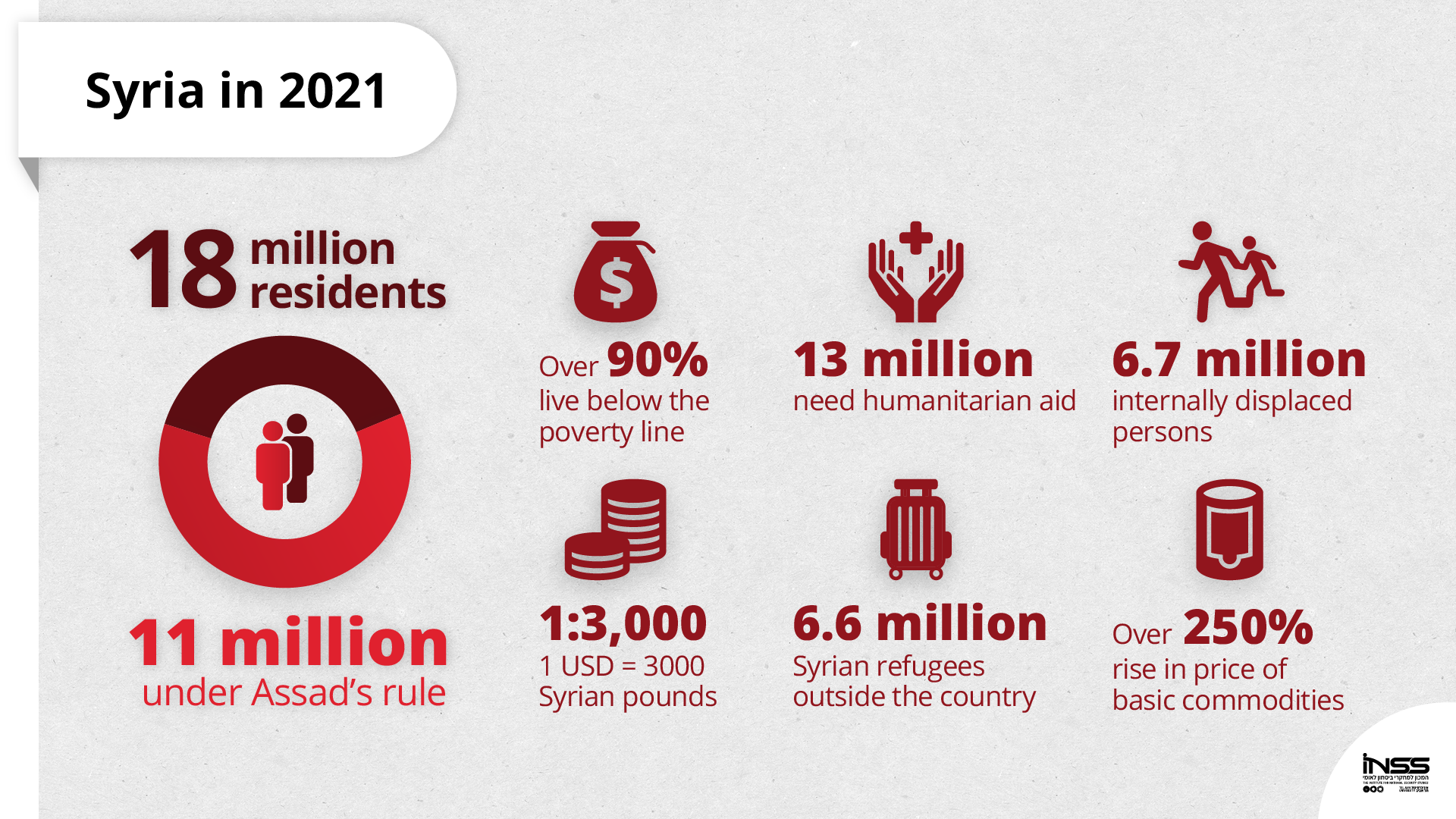
Despite the improvement in Assad’s regional status and his image as a functioning president, his actual control and governance over Syria are partial and limited. His dependence on external support – from Russia and Iran – remains high, and the economic state of the country is declining. Contrary to expectations, Assad is not likely to sever Syria from Iran, but on the other hand, he is not putting his full weight behind an effort to ensure the Iranian presence in his country.
Assad is currently focusing on maintaining his control over the two thirds of Syrian territory, covering the Daraa-Damascus-Homs-Hama-Aleppo axis, and the Alawite coastal strip in the west. The northeastern and northwestern parts of the country are still under the control of external groups – Kurds, United States, rebels, and Turkey. The Assad regime has no independent capability to regain full control of Syria.
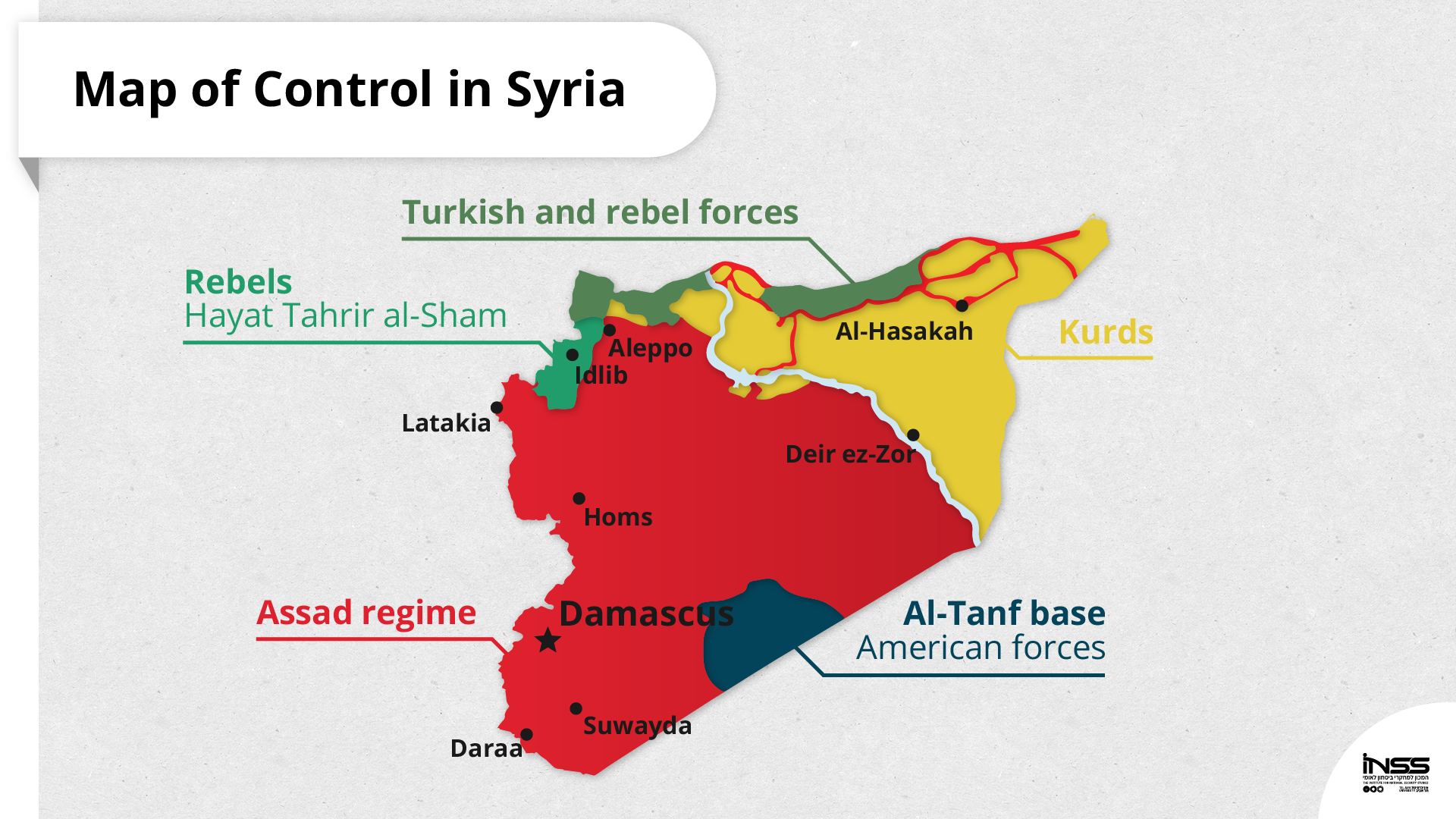
Continued Foreign Intervention
Russia maintains its dominant military and diplomatic role in Syria and is determined to reposition Assad’s status, while stabilizing the country and rebuilding the army. Moscow has an advantage in its economic projects and agreements in Syria involving oil, gas, and phosphate resources. The competition between Russia and Iran for military and economic influence in Syria exists, but has not reached a point that will threaten the strategic relations between them in the coming year. Other than the dispute over recognition of Assad, relations and communication between Russia and the United States in the Syrian context have clearly improved. The strategic coordination with Israel has been preserved; despite periodic Russian statements about aid for the Syrian air defense system against Israeli air attacks, it is evident that Russia accepts the offensive activity by the IDF (the campaign between wars), as long as it is focused on attacking the military capabilities of Iran and its proxies in Syria, as well as neutralizing the Assad regime’s ability to develop weapons of mass destruction.
Notwithstanding its commitment to keep American forces in Syria and the lesson that it learned from its hasty exit from Afghanistan, the Biden administration has shown limited interest in the Syrian theater, and has yet to formulate a comprehensive strategy for dealing with the crisis in the country. At this stage, the administration is focused on four goals: easing the violence and improving the humanitarian situation; continuing the fight against ISIS; opposing official recognition of Assad; and demanding implementation of UN Security Council Resolution 2254 in any arrangement in Syria. In the coming year, the administration will have to maneuver between two sources of tension: one, the conflict between its determination to maintain the sanctions against the regime and its associates, and its desire to relieve the humanitarian situation and allow a free flow of money for reconstruction of infrastructure; and two, the US commitment to aid the democratic Kurdish forces in northeastern Syria, which requires the deployment of US forces in the area, thereby exposing these forces to attacks by Iranian proxies aiming for the departure of American forces from Iraq and Syria. The Israeli challenge is to convince the administration that expelling Iranian capabilities from Syria is a key element in the strategic campaign against Iran, even in a scenario of a return to the nuclear agreement, after which Iran will be able to allocate additional resources to the consolidation of its presence on Israel’s northern front.
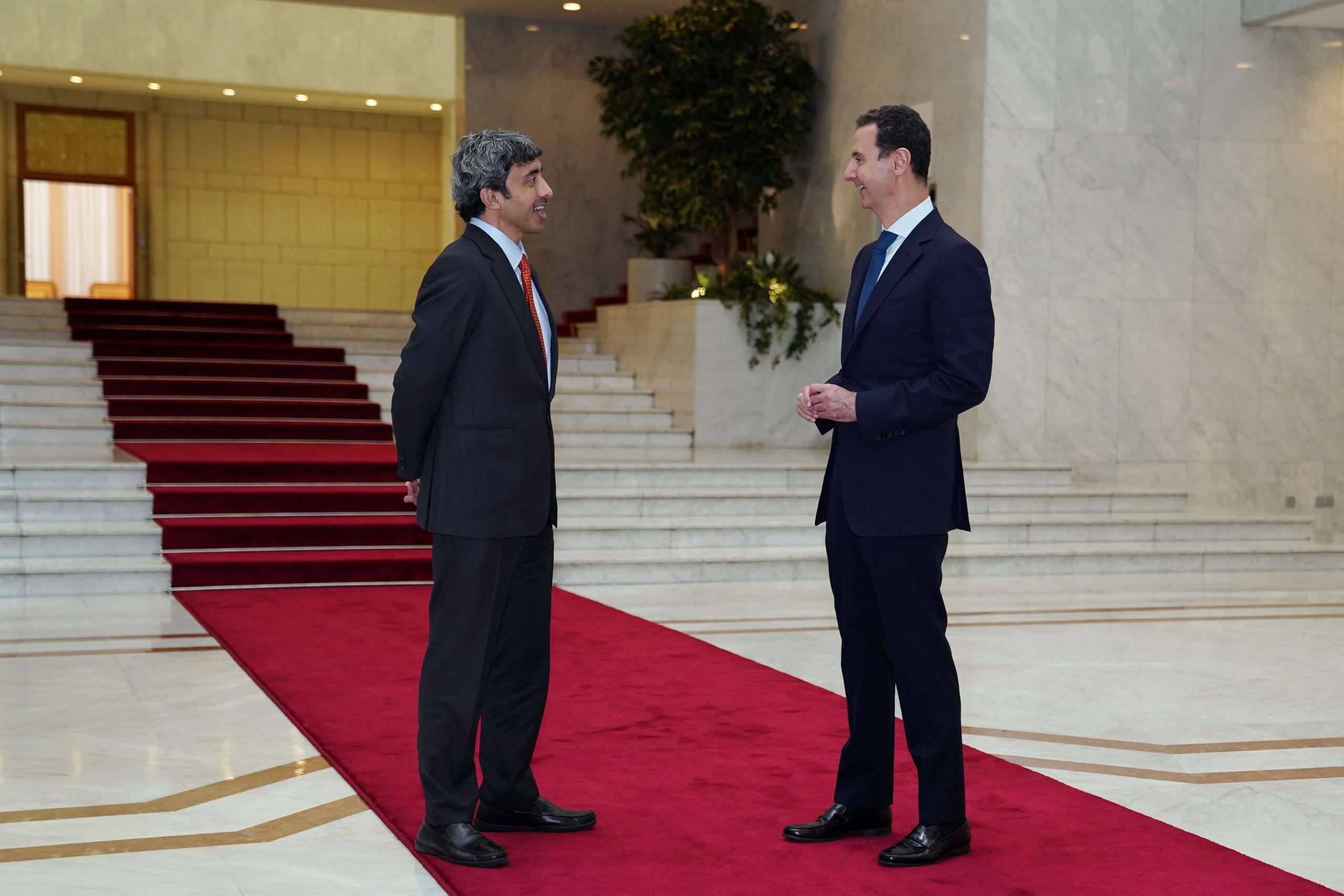
Sunni states are renewing their ties with Assad. Syria’s president meets with the UAE foreign minister, November 2021
Photo: SANA/Handout via REUTERS
Iran’s military and civilian entrenchment in Syria continues, but reflects an adjustment to the changing circumstances, and is on a more reduced scale than in the original Iranian plan. Israel’s stepped-up campaign between wars, the economic challenge, and pressure from Russia all hinder the full realization of Iran’s military buildup and enhancement of its sphere of influence as a platform against Israel. In tandem, the transfer of weapons and the improvement of local production capabilities in Lebanon for Syria and for Hezbollah continue. Iran is consolidating and reinforcing its influence in Syria through Hezbollah and local militias that it founded. It holds over 100 military sites throughout the country, controls about 20 percent of Syria’s borders, transfers Iranian-made air defense systems aimed at protecting its military bases and assets in Syria and Lebanon, and smuggles attack UAVs to Syria.
Turkey controls strips of territory in northern Syria along its border, including three million Syrians. Ankara is troubled by the emergence of Kurdish autonomy, and fears that another wave of refugees will enter its territory. It therefore intends to design a security zone stretching from Jarabulus to Qamishli, where it plans to settle refugees. The Islamist rebel enclaves in Idlib, led by the Hayat Tahrir al-Sham organization, which is under Turkish influence and direction, has remained the main area of fighting against the Assad regime. In the coming years, the Turkish presence will remain an important barrier to realization of the Syrian-Russian objective of gaining control of the area by force.
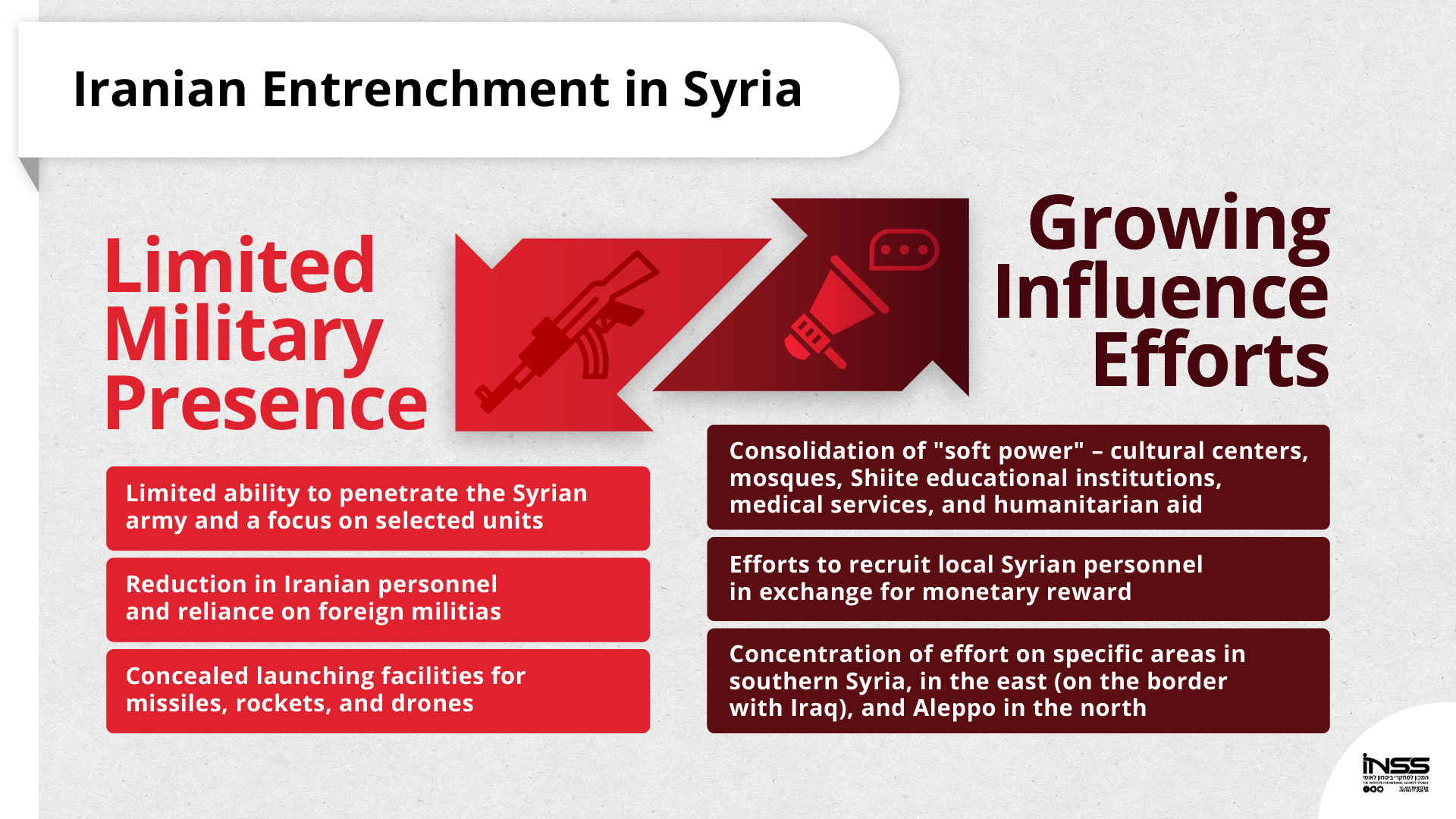
Lebanon
The main development in Lebanon in 2021 was the country’s ongoing rapid internal breakdown, in particular, the complete collapse of its economic and financial system, the ongoing paralysis of its political system (including after the formation of the new government headed by Najib Mikati in September 2021), and the nonfunctioning infrastructure, especially in the areas of electricity and energy, healthcare, and food and water services. This compounded the large number of violent incidents and loss of control by the Lebanese army, which suffers from an inadequate budget and large-scale desertion. The population in Lebanon is absolutely helpless, with no hope on the horizon. More than three quarters of the population live below the poverty line. The background to the severe crisis, described by the World Bank as one of the three worst in the world since the mid-19th century, is the chronic diseases that have afflicted Lebanon in recent decades. The country’s ensuing decline has accelerated since mid-2019, following the outbreak of widespread popular protests in October 2019, the COVID-19 pandemic (since February 2019), and the horrific explosion in Beirut Port in August 2020. Lebanon suffered another severe blow in late 2021, when the Gulf states, led by Saudi Arabia, decided to step up their pressure on Lebanon, due to Hezbollah’s major role in management of the country.
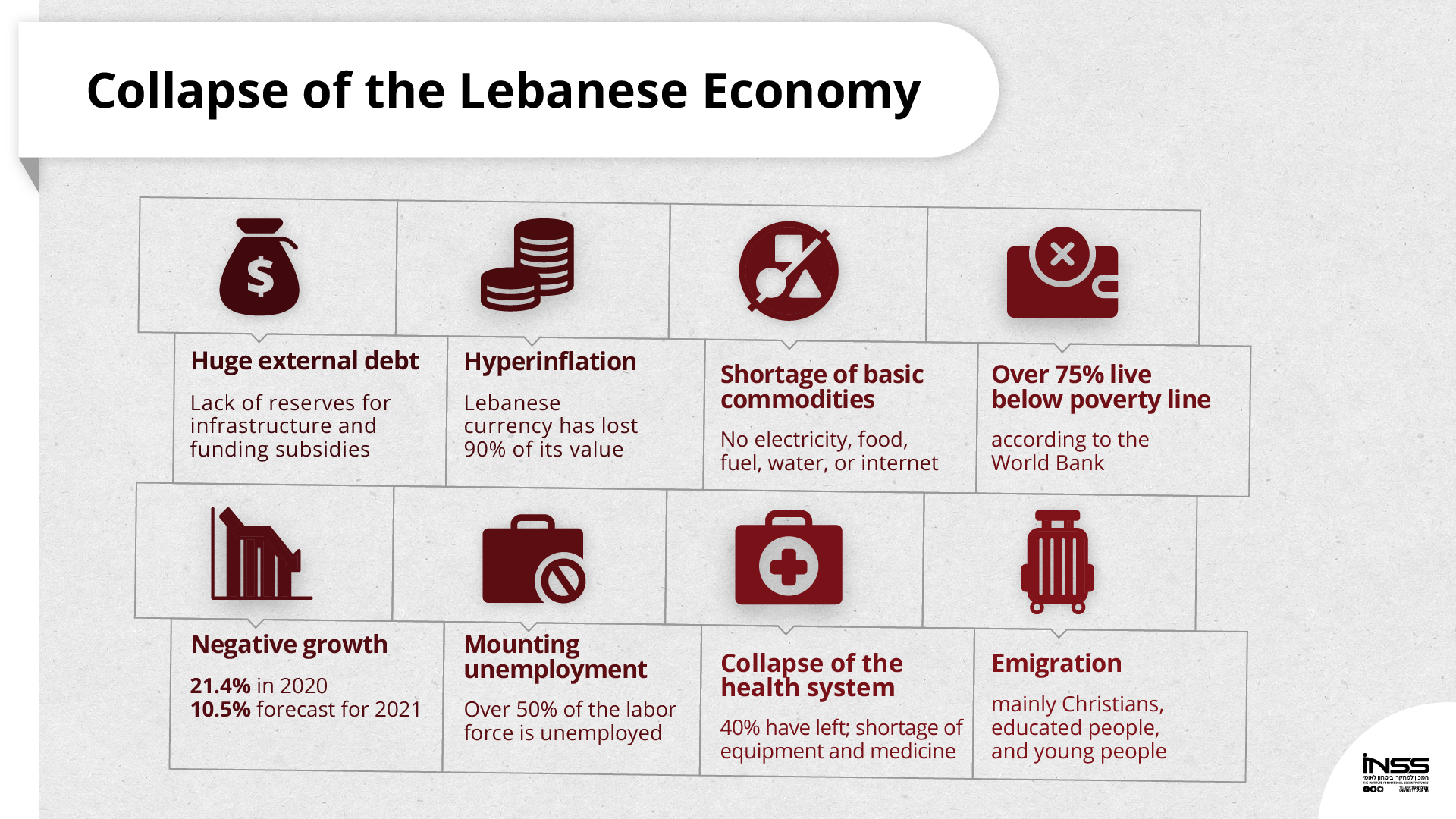
The Collapse of the Lebanese Economy
Hezbollah maintains its status and major influence in the decision making process in Lebanon. Some refer to the new government formed in September as a “Hezbollah government,” because Hezbollah influences or paralyzes its decisions, depending on its interests. Its demands for the dismissal of the judge investigating the explosion in Beirut Port and its position on the crisis with Saudi Arabia and the Gulf states prevented the government’s formation for a prolonged period. At the same time, Hezbollah maintains its independent activity, allegedly for the benefit of Lebanon. This detracts from Lebanese sovereignty, for example, by taking advantage of the energy crisis to bring diesel fuel into Lebanon from Iran (starting in mid-September 2021), especially when Hezbollah decides who will receive the fuel, and at what price. At the same time, together with the continued pressure on Hezbollah in the international theater, criticism of Hezbollah in Lebanon has recently mounted, including regarding its activity against Israel. There is also a clear increase in violent clashes between members of Hezbollah and its opponents in Lebanon, as evidenced by the violent clash between Hezbollah operatives and members of the Lebanese forces in Beirut in mid-October.
Hezbollah persists in its efforts to build up its military forces, with assistance from Iran – particularly continuation of the precision missiles project and procurement of air defense systems, while trying to maintain its deterrence equation with the IDF. At the same time, it is clear that the crisis in Lebanon and the criticism of Hezbollah in its home territory constitute a restraining factor in its activity against Israel. Hamas’s efforts to operate from the Lebanese border according to the precedent set in Operation Guardian of the Walls pose another challenge to both Israel and Hezbollah itself.
For Israel, the crisis in Lebanon poses a dilemma: whether and how to help alleviate the plight of the population in Lebanon without indirectly strengthening Hezbollah; how to prevent an absolute takeover of the Lebanese state by Hezbollah and Iran; and in the military sphere, whether Israel should change the way it operates against Hezbollah, and especially under what conditions Israel would have to attack Hezbollah’s precision missiles project in Lebanon directly.
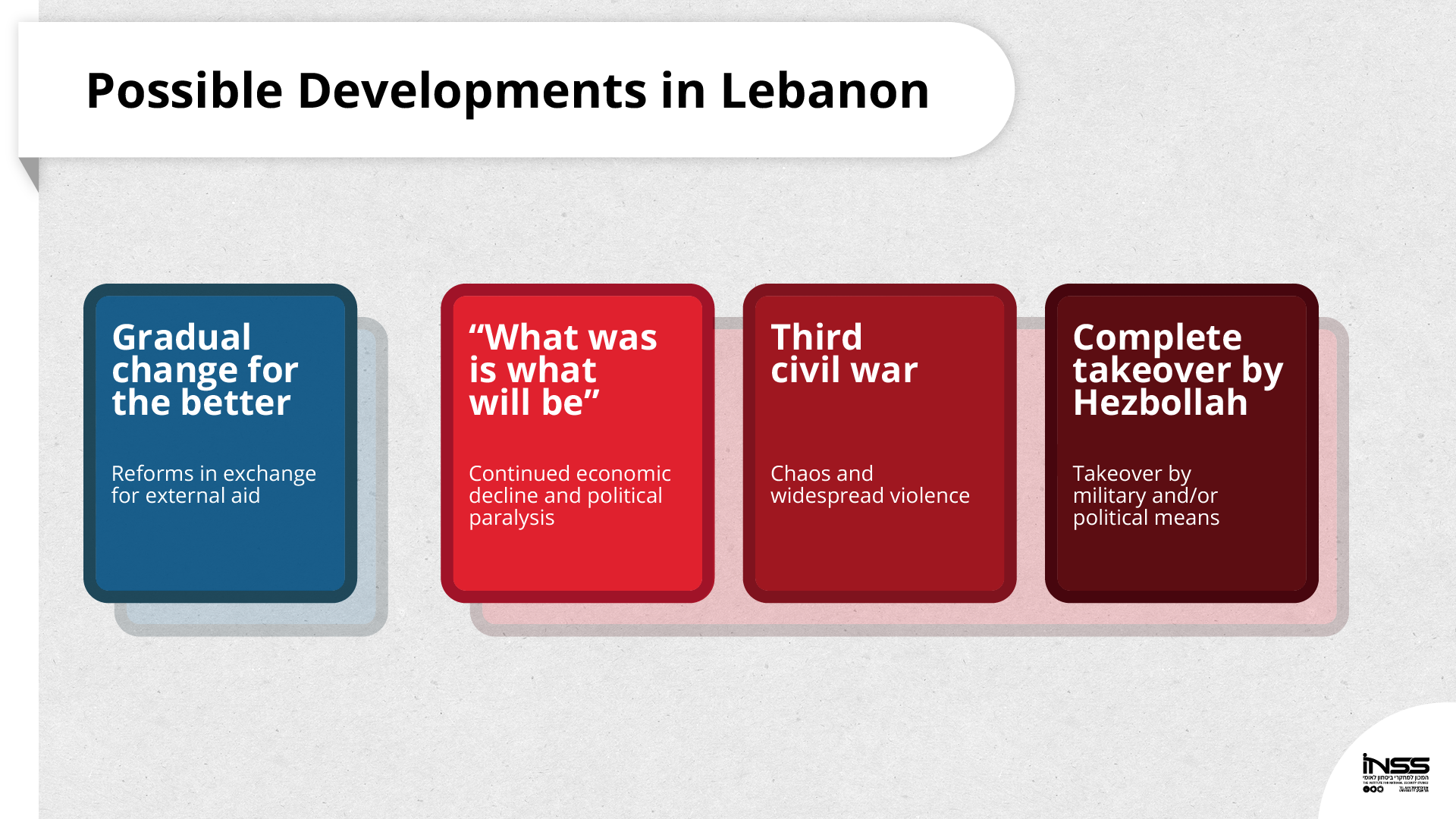
Policy Recommendations: Syria and Lebanon
The Assad regime will likely not succeed in gaining control of all parts of Syria in 2022, and will not expel Iran and its proxies from the country. Iran will persist in its multidimensional efforts to consolidate its presence in the country and preserve its influence there; transfer weapons to Hezbollah in Lebanon, with an emphasis on precision components for missiles and rockets and attack unmanned aerial vehicle in Syria and Lebanon; and build offensive capabilities against Israel from Lebanon, Syria, and western Iraq. Hezbollah will maintain its growing influence in Lebanon in all dimensions – political, military, economic, and social – despite the growing internal and external pressure on it. The chances of a significant change in the political order in Lebanon following the parliamentary elections scheduled for 2022 are slim, at best.
The response – implementation of a dual policy – emphasis on independent actions by Israel, along with willingness to cooperate with regional allies and positive local groups.
The Self-Reliance Approach
Given the situation in what is in effect a divided Syria, with the Assad regime unable to take control of the entire country, it is important to identify local allies – local communities in southern Syria, leaders of the Druze community in the Suwayda district, Kurds in eastern Syria – open a dialogue with them, and provide them with direct and indirect humanitarian aid. It is also recommended, in cooperation with local power groups, to encourage efforts to oppose the consolidation of the Iranian presence and that of its proxies and Hezbollah’s freedom of action in Syria. In order to win their confidence, it is important for Israel to refrain from officially recognizing the Assad regime, even implicitly.
Israel should persist in its prolonged campaign between wars to push Iran and its proxies out of Syria, with an emphasis on southern Syria. This requires adapting the campaign to the unfolding challenges and expanding the special and clandestine operations against Iranian strongholds in Syria and against groups cooperating with Iran and Hezbollah, including in the Syrian army and among the Syrian intelligence agencies. The Assad regime should be prevented from rebuilding its chemical weapons and transferring them to Hezbollah in Lebanon. At the same time, air defense systems liable to restrict the Israel Air Force’s freedom of action in the airspace of Syria and Lebanon should be neutralized.
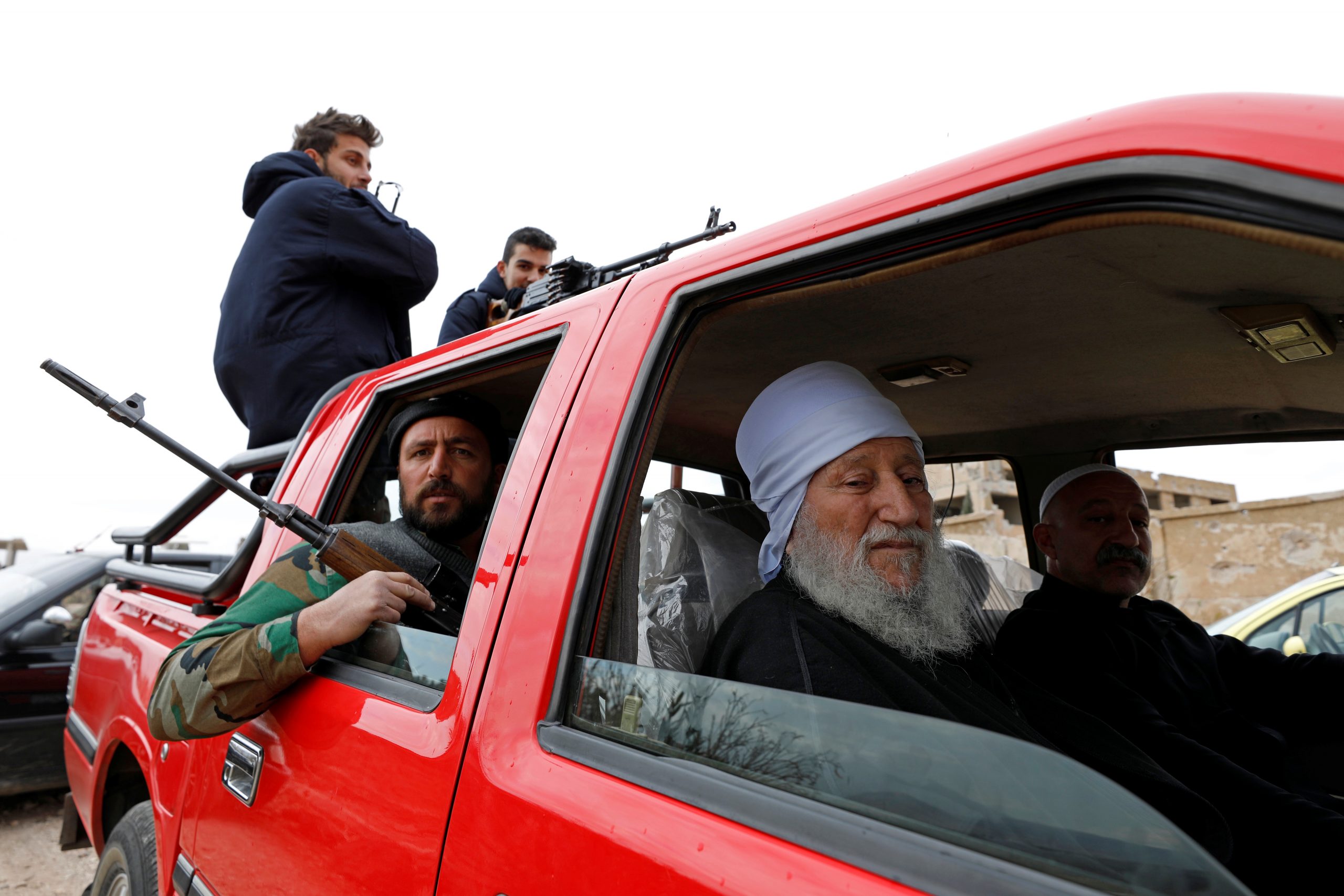
Israel should engage in dialogue with local allies in Syria. Evacuation of Druze from Beit Jann at the foot of the Syrian Hermon
Photo: REUTERS/Omar Sanadik
Strategic and military coordination with Russia, a leading power in Syria capable of limiting both the IDF’s freedom of action in the Syrian airspace and the extent of Iranian military consolidation, should be maintained. This will require expansion of the strategic dialogue with Moscow, while deepening operational coordination in order to prevent friction with Russian military forces.
It is necessary to prepare operational options for attacking the precision missiles project in Lebanon, among them an outline for a preemptive strike – taking advantage of an escalation event with Hezbollah to attack the precision infrastructure and air defense batteries in Lebanon. At the same time, it is necessary to improve readiness and preparedness for a dynamic of escalation in developments that are liable to lead to war on the northern front, despite the mutual interest in keeping such events below the war threshold.
It is recommended to devise a channel for exchanging messages with the Assad regime, in parallel with the coordination mechanism with Russia, in order to facilitate control of the war arena in accordance with Israel’s needs – confining it exclusively to the Lebanese front or expanding it to Syria and western Iraq.
A Multilateral Cooperative Approach
An effort should be made to induce the Gulf states, Jordan, and Egypt to make normalization with the Assad regime contingent on reducing the influence of Iran and Hezbollah, with an emphasis on preventing their deployment in southern Syria. Cooperation with Jordan should be strengthened in supporting groups in southern Syria opposed to Iranian entrenchment and Hezbollah operations in the area.
The tripartite coordination between the United States, Russia, and Israel should be strengthened, in the realization that Syria’s future depends on agreements and coordination between Russia and the United States. Israel should encourage the Biden administration to be more flexible toward Russia in order to achieve mutual understandings on thwarting Iran’s negative influence in the region. At the same time, it is necessary to promote an understanding in the region and throughout the world of the negative consequences of the activity by Iran and its proxies, which destabilize this theater. Intelligence connections, diplomatic dialogue, and influence efforts should be employed in this campaign. The objective is to encourage international coordination, with a focus on weakening Iran and Hezbollah and limiting subversion by the Shiite axis. Special emphasis lies on a possible return to the nuclear agreement and the removal of the sanctions against Iran, which will enable it to devote large resources to support its proxies and rogue actors throughout the region. It is recommended to establish a mechanism for consulting with the United States, the Gulf states, Jordan, and Egypt on restraining the negative Iranian influence and formulating alternatives to Iranian support in Syria and Lebanon.
With respect to the failing Lebanese state, there is a clear preference for preserving the country, in other words, not remaining indifferent, and taking action to delay/prevent its collapse. The existing situation of multiple ruling centers in Lebanon and the system of balances between them (though flawed), based on the Taif Agreement, is preferable to a complete takeover of the country by Hezbollah in the service of Iran. For this purpose, a broad-based coalition of countries should be formed, led by the United States, France, and Saudi Arabia, to send humanitarian aid directly to the Lebanese population and aid in the restoration of functioning state systems. At the same time, an international coalition should be formed in an effort to restrict the influence of Iran and Hezbollah, and to strengthen Hezbollah’s opponents in Lebanon. For its part, Israel can demonstrate flexibility in the discussion of the maritime border, including arrangements on the supply of energy, inter alia, from the disputed maritime areas.


